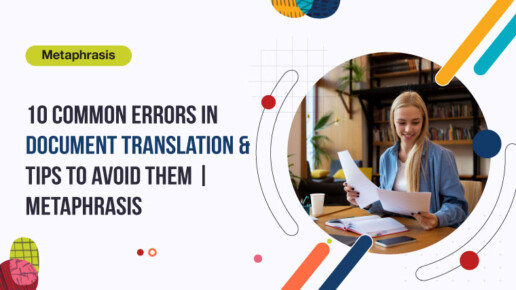10 Common Errors in Document Translation and Tips to Avoid Them | Metaphrasis
Document translation is a critical aspect of communication in our globalized world. Whether it’s legal documents, marketing materials, or technical manuals, accurate translation is vital to conveying the intended message. However, the process is not without its challenges, leading to 10 Common Errors in Document Translation that can have far-reaching consequences.
Introduction
In today’s interconnected world, document translation plays a pivotal role in breaking down language barriers. From multinational corporations to small businesses, the need for clear and precise translations is ever-present. But what happens when these translations go awry?
Common Errors in Document Translation
Literal Translation Pitfalls
One of the most frequent errors in document translation is relying too heavily on literal translations. This approach often overlooks cultural nuances and can result in messages that sound awkward or even offensive in the target language.
Cultural Nuances and Misunderstandings
Cultural differences can be a minefield for translators. Failure to understand the cultural context of certain phrases or idioms can lead to misunderstandings that go beyond linguistic errors.
Inconsistencies in Terminology
Maintaining consistency in terminology is crucial, yet it’s a common stumbling block. Translators must ensure that key terms are translated consistently throughout the document.
Grammatical Errors
Grammatical mistakes can significantly impact the readability and comprehension of a translated document. Translators need a deep understanding of both source and target languages to navigate complex grammatical structures.
Machine Translation Limitations
While technology has advanced, relying solely on machine translation can lead to inaccuracies. Understanding the limitations of automated tools is essential to producing high-quality translations.
The Impact of Translation Errors
Legal Consequences
Inaccurate translations can have legal ramifications. Contracts, agreements, or legal documents must be translated with precision to avoid misunderstandings that could lead to legal disputes.
Reputational Damage
Translation errors can harm a company’s reputation. A poorly translated marketing message or product description can create a negative perception among potential customers.
Loss of Business Opportunities
Missed nuances in communication may result in lost business opportunities. In a competitive global market, effective communication is a key factor in securing partnerships and collaborations.
Tips to Avoid Translation Errors
Professional Translators
Investing in professional translators with expertise in the subject matter ensures accurate and culturally sensitive translations.
Utilize Translation Tools Wisely
While technology aids the translation process, it should complement, not replace, human expertise. Translators should use automated tools judiciously.
Maintain Consistency in Terminology
Creating a glossary of industry-specific terms helps maintain consistency across translations, reducing the risk of errors.
Consider Cultural Context
Translators must understand the cultural context of the content to convey messages accurately and avoid cultural faux pas.
Proofread and Edit Translations
Thorough proofreading and editing are essential for catching grammatical errors and ensuring the overall quality of the translated document.
Real-Life Examples
Case Studies Illustrating Translation Errors
Examining real-life examples of translation errors provides valuable insights into the consequences and the lessons learned.
Lessons Learned from Past Mistakes
By analyzing past mistakes, businesses can implement strategies to prevent similar errors in the future.
The Role of Technology in Translation
Advancements in Translation Technology
Technological advancements have transformed the translation landscape, offering new tools and possibilities for more efficient and accurate translations.
Pros and Cons of Automated Translation Tools
While automated tools can expedite the translation process, understanding their limitations is crucial to avoiding errors.
Importance of Industry-Specific Knowledge
Tailoring Translations to Industry Standards
Translators with industry-specific knowledge can provide translations that align with the standards and requirements of a particular sector.
Avoiding Generic Language Pitfalls
Generic translations may not capture the nuances of industry-specific terminology, potentially leading to misinterpretations.
Building a Translation Strategy
Establishing Clear Communication with Translators
Effective communication between the client and translator is essential for understanding project requirements and expectations.
Creating a Glossary for Consistent Terminology
Developing a glossary helps maintain consistency and ensures accurate translations across various documents.
Continuous Improvement in Translation Processes
Learning from Feedback
Feedback from clients and end-users provides valuable insights for continuous improvement in the translation process.
Updating Translation Guidelines
Regularly updating guidelines based on feedback and industry developments enhances the efficiency and accuracy of translations.
Conclusion
In conclusion, the impact of document translation errors extends far beyond linguistic misunderstandings. Businesses must recognize the importance of investing in professional translation services and implementing robust strategies to avoid common pitfalls.

